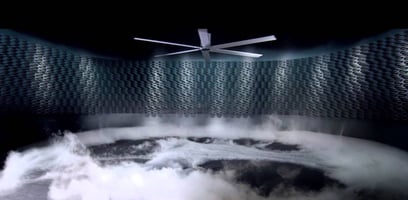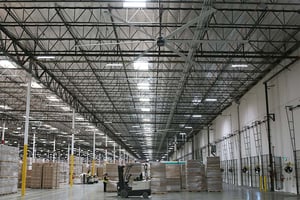Sweating Slab Syndrome (SSS) is a dangerous condition that plagues many warehouses and compromises...
The Super Easy Way to Get Fumes Out of Factories & Warehouses
Demands on facility managers stretch their ability to keep employees happy and productive, the workplace safe and clean, and the costs reasonable and predictable. Where building activities generate fumes, managers need to find easy and effective ways to keep their air clean. To learn more about solutions for warehouse managers to reduce fumes in their facilities, we interviewed warehouse cooling expert, Jim Stahl. Stahl advises several easy solutions to get fumes out of factories and warehouses.
Proper Infiltration/Exfiltration –
Every facility has some form of ventilation, but it may not be adequate or appropriate for the work being conducted there. A warehouse may include processes that produce heat and/or fumes and noxious odors. It is also likely that different processes will operate in various sections of the building. Without a remedy, the work becomes risky and the results costly.
Jim Stahl advises,
“Every building needs to have proper infiltration/exfiltration. You have to bring so much air in and so much air out to keep a balance.”
This is not something that the facility manager can leave to chance; the incoming and outgoing air need strategic control to rid the air of fumes.
Fumes Don’t Rise
Fumes often do not rise. Like the smoke and odors issued by propane forklift trucks, fumes actually lay low and resist dispersal. Even more, speeding up standard fans only churns the already bad air without getting rid of it. Cooling expert Jim Stahl notes,
“Just making sure equipment is current matters in terms of employee performance, safety, and efficiency.”
Opening and closing doors will flush out some of this problem air. However, keeping doors open is a security risk and a real negative where the outside air is cold, hot, or dirty. High Volume Low Speed (HVLS) fans will actually destroy the fume-filled air by moving such large volumes that it de-stratifies and reconfigures the air.
Noise is Noxious
Manufacturing and warehousing facilities are noisy. The people, the processes, and the machinery fill the air with tiresome noises. HVLS fans work quietly high above work areas and, when strategically placed, they can flush or disperse fumes near loading docks, toxic work areas, and leaching machines.
HVLS Fans Solve Complex Problems
The super-easy way to get fumes out of factories and warehouses may be to simply open doors and windows. However, thermodynamics will only move so much air so far. A high-cost HVAC will push the air about as if it were a solid mass, and the vents effectively only reach so far.
What you need is a system that redistributes the air. According to Jim Stahl,
“Even just by getting that air distributed in the building can increase that work experience. HVLS fans do just that.”
HVLS fans do more than blow the air in one direction. Just one fan, 24-feet in diameter, will move 20,000 pounds of air to the floor every minute. At the floor, it will jet across to the walls where it will rise again to be re-circulated. This is done with such force that the air and its contents are molecularly reconfigured. Strategically placed HVLS fans will direct the fumes to exhaust and ventilation devices. As Jim Stahl says,
“HVLS fans enhance existing ventilation systems.”
Summary
Fumes and noxious air must move. Otherwise, the air presents an unacceptable risk to building occupants, as well as to their morale and productivity. Machines like lathes and grinders radiate heat and particles. Processes like welding and painting poison the air, and equipment like forklift trucks and generators produce eye- and lung-burning toxins. HVLS fans integrated into existing circulation and ventilation systems provide a super easy and cost-effective way to remove fumes from factories and warehouses.
Subject matter expert, Jim Stahl, is well versed in HVAC and holds a Bachelor of Science degree in Business and Technology Management with an emphasis in Applied Science, specifically in HVAC/R Technologies.


